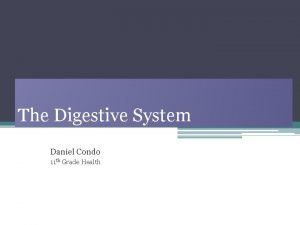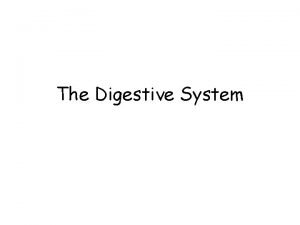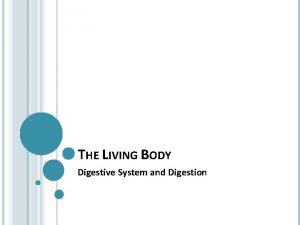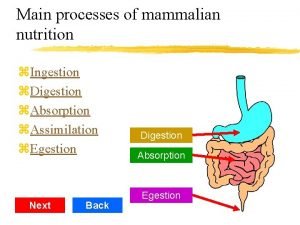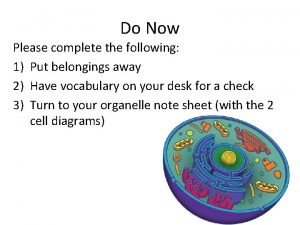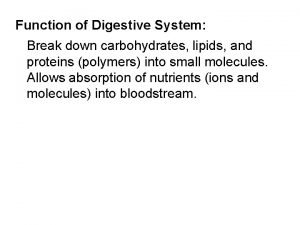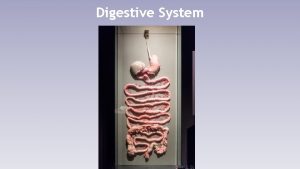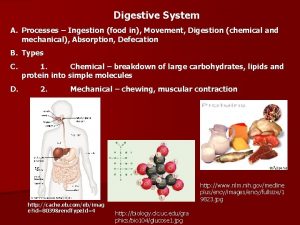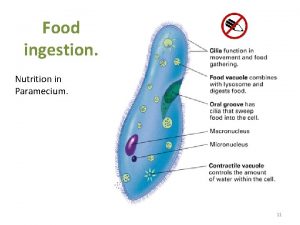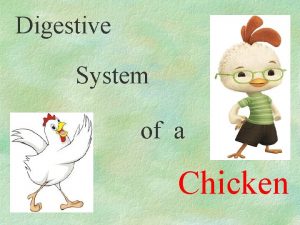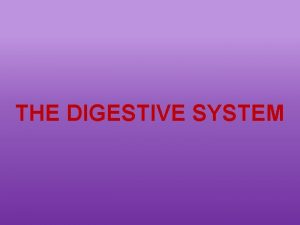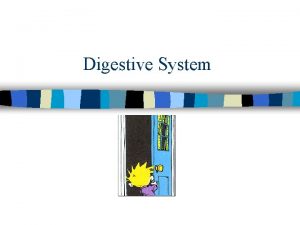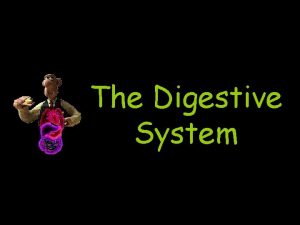The Digestive System Digestive Processes Ingestion taking fooddrink







































- Slides: 39

The Digestive System

Digestive Processes • Ingestion – taking food/drink into mouth. • Propulsion – movement through alimentary canal (swallowing, peristalsis). • Mechanical Digestion – Physical breakdown of food (chewing, churning).

• Chemical Digestion – Enzymatic breakdown of food (from complex to simple building blocks). • Absorption – transport of digested products from lumen of G. I. tract to blood and lymph (inside body). • Defecation – elimination of indigestable and waste products from body (feces).



Salivary Glands Intrinsic (inside oral cavity) e. g. , lips & cheeks. Extrinsic (outside oral cavity): “Mumps” 1) Parotid (largest) - a serous gland. 2) Submandibular - a serous gland. 3) Sublingual (smallest) - a mucus gland • Lingual amylase (breaks down starch). • Lysozyme – antibacterial agent in saliva.

The Oral Cavity Typical Adult Teeth (in one quadrant) Incisors Canines Premolars Molars 2 1 2 3 = 8 Times 4 quadrants: Total: 4 x 8 = 32


• The Esophagus - is a Muscular tube. – approx. 10 inches long. – Transition from skeletal to smooth muscle. (hence voluntary to involuntary) – Mucous glands in tela submucosa (layer) to lubricate bolus. – Outermost layer is Adventitia or Serosa. outside peritoneal cavity inside peritoneal cavity

• The Stomach - an acidic storage area.

• Stomach – acidic (p. H 2) storage of chyme. Mechanical Digestion continued (churning). Has 3 muscle layers, for churning. • Enzymatic Digestion of proteins occurs here (Pepsin breaksdown proteins). • Only Absorption of alcohol and aspirin. • Rugae allows for expansion when volume of contents increase.

Can you identify the 4 Tunics? Unique in the GI tract, the stomach has 3 muscle layers:

Production and secretion of gastric juices controlled by CNS. e. g. , Vagus nerve Parietal cells: make Hydrocholic acid (HCl) in gastric glands. Chief cells: make Pepsinogen, which is cleaved to pepsin (↑HCl), to digest proteins.

Gastric Bypass (Malabsorptive) Surgery

Small Intestine: Chemical Digestion/Absorption Duodenum Jejunum Ileum Increase Surface Area for Absorption 1) Plicae Circulares 2) Villi (Intestinal) 3) Microvilli Lacteals absorption lipids Intestinal glands Goblet cells Stem cells

The Small Intestine

Villi of Small Intestine Vascular Arcade (from superior mesenteric a. ) Mesentery Proper - is a double layered serous membrane attached to the small intestine. Roles: - Supports branches of blood vessels. - Supports lymphatics of the jejunum and ileum. - Supports nerves of the jejunum and ileum.

The Mesentery Proper of the Small Intestine The Greater Omentum

Distinguishing features of each region of the Small Intestine

The Large Intestine Begins as pouch inferior to end of ileum Ends at anus. Functions of Large Intestine: 1) Reabsorb water and compact feces. 2) Absorb vitamins (helps make Vit K) electrolytes. 3) Stores fecal matter. The Cecum: – Contains the Ileocecal valve and connected to appendix. The Colon: – Ascending, Transverse, Descending, Sigmoid.


The Colon • Lack of villi • Abundance of goblet cells • Abundance of mucous-secreting intestinal glands

The Rectum and Anus


The Liver


Diagrammatic view of Liver lobular organization.

Anatomy between the Liver (makes Bile), the Gallbladder (stores and concentrates bile), and the Pancreas (makes/releases pancreatic juices) into the Duodenum.

The roles of the Greater and Lesser Duodenal Papillae

Histology of the Pancreas Exocrine Gland: Pancreatic Juices § Amylases § Proteases § Lipases Endocrine Gland: Makes Hormones § Insulin § Glucagon § Somatostatin § Gastrin

Histology of the G. I. Tract

A Mucous Membrane • Lines entire digestive tract • Moistened by glandular secretions • Simple or stratified depending on area of tract • Pleated for expansion (↑Surface Area)

These are the 4 Layers! 1. Tunica Mucosa is a Mucous Membrane (wet, absorbs, protects) 1) Epithelium 2) Lamina propria 3) Muscularis mucosae 2. Tela Submucosa Areolar Connective Tissue Contains: Submucosal plexus (nervous innervation) Blood and Lymphatic Vessels

3. Tunica Muscularis Externa Smooth muscle layers 1) Inner Circular Layer 2) Outer Longitudinal Layer What are some exceptions? Myenteric Plexus 4. Tunica Serosa (or Adventitia*) Serous membrane – aka visceral peritoneum * Name depends on location: a) Inside peritoneal cavity = serosa b) Outside peritoneal cavity = adventitia


Layers: How are they different in each diagram above? 1. ________ 2. _______ 3. ________ 4. ________

The Peritoneum: Two layers Visceral peritoneum (a. k. a. serosa) Parietal peritoneum - Lines inner surfaces of body wall Mesenteries: – Fused double sheets of peritoneal membrane to suspend portions of digestive tract: e. g. Greater omentum Lesser omentum Mesentery proper Mesocolon

Retroperitoneal Structures – these are attached to posterior abdominal wall, and are not in the peritoneal cavity. e. g. - Most of the Duodenum - Ascending colon - Descending colon - Pancreas

Horizontal section through the upper abdomen showing the position of the liver relative to other visceral organs.
 Digestion system image
Digestion system image What is the function of anus
What is the function of anus It is where most of the absorption process happen
It is where most of the absorption process happen Concurrent in os
Concurrent in os Respiratory system circulatory system digestive system
Respiratory system circulatory system digestive system Ingestion and digestion
Ingestion and digestion Ingestion and digestion
Ingestion and digestion Metadata driven ingestion framework
Metadata driven ingestion framework Passenger management system
Passenger management system Stripping de l oesophage
Stripping de l oesophage Examples of carbohydrase
Examples of carbohydrase Ingestion digestion absorption assimilation egestion order
Ingestion digestion absorption assimilation egestion order Fundus gastrico
Fundus gastrico Cell wall function
Cell wall function Disposerx solving the problem of drug disposal
Disposerx solving the problem of drug disposal Process of ingestion
Process of ingestion Ingestion of food
Ingestion of food Nervous system and digestive system
Nervous system and digestive system Hát kết hợp bộ gõ cơ thể
Hát kết hợp bộ gõ cơ thể Ng-html
Ng-html Bổ thể
Bổ thể Tỉ lệ cơ thể trẻ em
Tỉ lệ cơ thể trẻ em Voi kéo gỗ như thế nào
Voi kéo gỗ như thế nào Tư thế worms-breton
Tư thế worms-breton Alleluia hat len nguoi oi
Alleluia hat len nguoi oi Môn thể thao bắt đầu bằng chữ đua
Môn thể thao bắt đầu bằng chữ đua Thế nào là hệ số cao nhất
Thế nào là hệ số cao nhất Các châu lục và đại dương trên thế giới
Các châu lục và đại dương trên thế giới Công thức tính thế năng
Công thức tính thế năng Trời xanh đây là của chúng ta thể thơ
Trời xanh đây là của chúng ta thể thơ Cách giải mật thư tọa độ
Cách giải mật thư tọa độ 101012 bằng
101012 bằng độ dài liên kết
độ dài liên kết Các châu lục và đại dương trên thế giới
Các châu lục và đại dương trên thế giới Thể thơ truyền thống
Thể thơ truyền thống Quá trình desamine hóa có thể tạo ra
Quá trình desamine hóa có thể tạo ra Một số thể thơ truyền thống
Một số thể thơ truyền thống Cái miệng nó xinh thế
Cái miệng nó xinh thế Vẽ hình chiếu vuông góc của vật thể sau
Vẽ hình chiếu vuông góc của vật thể sau Thế nào là sự mỏi cơ
Thế nào là sự mỏi cơ

